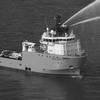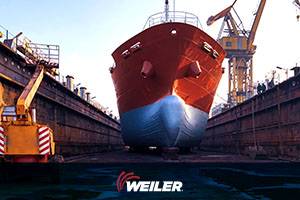Navigating Obstacles: Short Sea Shipping
From MarineNews, January 2010
Short-sea shipping, also referred to as the “Marine Highway” and, in some cases, “coastal shipping,” is the subject of more studies than we can list. Whatever the label, the concept refers to an initiative to get freight off our roadways, which are at capacity, and onto our waterways, which have to yet to be tapped to their potential. More than likely you’ve heard about the promises of this mode of transport, including reduced highway congestion, reduced consumption of fuel and fewer emissions per unit shipped. So what’s the hold up? In the following pages MarineNews looks at the obstacles that stand between the concept and the reality.
Two major studies
Dr. Rockford Weitz is a Senior Fellow at the Institute for Global Maritime Studies and co-author of the September 2008 study “America's Deep Blue Highway: How Coastal Shipping Could Reduce Traffic Congestion, Lower Pollution, and Bolster National Security.” Weitz prefers the term “coastal shipping” because he excludes brown water operations from his research and believes “short-sea shipping” is not a very useful term to get those “people in Washington, who don’t know the difference between a bow and a stern, onboard with this.”
According to the study, “The U.S. today moves by sea an almost negligible two percent of domestic freight among the lower forty-eight states; in stark contrast, Europe ships over 40% of its domestic freight along ‘motorways of the sea.’” One of the study’s recommendations is that the U.S. invest $150m in prospective coastal shipping ports. “This amount, equivalent to the cost of constructing only about twenty miles of expressway, would be sufficient to jumpstart coastal shipping services on the Atlantic, Gulf, Pacific and Great Lakes coasts,” it contended.
A previous study, “Four Corridor Case Studies of Short-Sea Shipping Services: Short-Sea Shipping Business Case Analysis,” was completed for MARAD in August 2006. The objective of this study was to assess the feasibility of short-sea shipping in four potential domestic U.S. traffic corridors: the Gulf to and from the Atlantic Coast, the Atlantic Coast, the Pacific Coast and the Great Lakes.
The obstacles
Some of the obstacles to short-sea shipping noted in these studies, and by other sources, are slowly being addressed, while othera may simply be a fact of life. In September 2009, the U.S. Saint Lawrence Seaway Development Corporation (SLSDC) and its counter-part, the Canadian St. Lawrence Seaway Management Corporation (SLSMC), went on a fact-finding mission to Europe to determine why short-sea shipping was so successful in that part of the globe, but far less so in North America. U.S. and Canadian regulatory barriers were discovered to be one of the biggest obstacles, including cabotage and tax laws. The U.S. has the Jones Act and Canada has a 25% tax on non-Canadian built / flagged ships. These laws, especially the Jones Act, can be touchy subjects, but Terry Johnson, SLSDC Administrator, said, “I think we can be honest and straight forward and say that they are big barriers to having short-sea shipping take off.” Johnson reported that Canada is in process of repealing their 25% tax, at least for vessels of a certain size. “On our side, of course,” he said “the Jones Act isn’t going anywhere.”
The America’s Deep Blue Highway study demonstrated that it’s a game of give and take, as Europe already knows. The study noted that “this impressive use of coastal shipping has come with some pain because liberalizing Europe’s domestic shipping market has been accompanied by ‘flagging out’ by some operators and a loss of European shipboard jobs to lower wage foreign competitors.” Weitz said the crewing and flagging of a vessel have very little impact on the cost — it’s the price of building vessels in the U.S. that puts short-sea shipping at a significant disadvantage to trucking. Trucks on U.S. roadways can be built anywhere in the world.
What may be going somewhere, someday, is the U.S.’s Harbor Maintenance Tax (HMT). The HMT is a federal tax imposed on each individual shipper, not the vessel operator, based on the value of the goods being shipped through a port. The tax is placed in a trust fund to be used for maintenance dredging of federal navigational channels. The revenue from the tax is not very great, opponents argue, because shippers simply opt to use roadways where the tax does not apply. Furthermore, many argue that the tax is an unfair burden to shallow-draft coastal and inland shipping, which does not require the harbor dredging necessary for the deep-draft trans-oceanic ships. Gregg Ward, Vice President of Detroit-Windsor Truck Ferry, a short-sea RoRo service on the Great Lakes since 1990, said “Currently industry is rallying support around H.R. 3486 – Short Sea Shipping Act of 2009. In September we had 12 members of Congress who supported this bill. Today, we have 34.” Ward said support is continuing to grow and he hopes Congress will move the bill forward in 2010.
Shipping time continues to be a detractor, even though many advocates of short-sea shipping limit the conversation to non-time sensitive freight. In some areas, time is still a consideration for short-sea shipping to gain the smallest foothold, even if all other factors were favorable. Dr. Matthew P. Tedesco, teamed with Westar Transport, CDI Marine, and Transystems / Manalytics on the study “Operational Development of Marine Highways to Serve the U.S. Pacific Coast,” released in September 2009. Tedesco said “The San Francisco region to Los Angeles / Long Beach (LA / LB) has the greatest volume of trailers moving daily in both directions [on the West Coast], however it is only about a 400 mile route. As a result, it is a challenge to make it work commercially. In order to provide a comparable level of service as trucking, vessel speeds of approximately 27 knots are required.”
The America’s Deep Blue Highways study also addressed this concern, saying “Barges and articulated tug-barges have an important role to play in a diversified, thriving marine highway, but they tend to carry low-value goods that require only slow transit times. Many previous market studies of U.S. coastal shipping suggest that barge speeds are simply too slow to compete effectively with a large share of existing road and rail traffic. Thus we recommend that America’s policy discussion on a revitalized coastal shipping industry focus more attention on ships with service speeds in the twenty-knot range.” This is connected to a proposition in the study that a U.S. fleet of CNG vessels, built specifically for short-sea routes, be explored.
Other obstacles include a lack of infrastructure to support a short-sea shipping market. Although this is far from remedied, in 2009 ports did begin to see funds for capital improvements filter down from President Obama’s stimulus package. Finally, labor union issues have been cited as a potential obstacle. MARAD’s Four Corridor study documented concern on behalf of shippers that traffic moving through ports could incur costly delays due to the involvement of longshore labor. In the study, port operators also cited likely difficulty in obtaining new labor agreements for short-sea shipping, specifically on the Pacific Coast.
No one-size-fits-all solution
The America’s Deep Blue Highways study contended that any disagreement over short-sea shipping is about how to move freight off the roadways and onto the waterways, not whether it should be done. “Some argue in favor of moving the standard size steel container, denominated in twenty-foot equivalent units (TEUs), in a hub and spoke system from international ports to domestic routes. Others think it better to leapfrog busy international terminals with fifty-three foot domestic tractor-trailers, that length accounting for approximately 90% of all U.S. truck traffic. The other main difference among coastal shipping experts concerns the kind of vessel to engage in this work. One camp supports Load-on Load-off (LoLo) vessels, often tug and barge, requiring shoreside cranes to move cargo. A competing group thinks the solution will be found in Roll-on Roll-off (RoRo) ships, where the cargo is driven aboard at the source and driven ashore at the destination.”
Your perspective probably depends on where you are. Weitz explained that for the east coast, RoRo seems to be the most applicable method, with fairly quick turn-around times. It could also be done with a fairly reasonable infrastructure investment. According to his study, “a typical Atlantic port can be prepared to handle RoRo traffic with a $5m investment. An incremental investment of approximately $50m would be needed to increase daily capacity along the Atlantic Coast to a total of 21,000 trailers.” Supporting the viability of short-sea shipping on the East Coast, the Four Corridor study found that the largest inter-regional traffic flow in the U.S. is from the Gulf Coast to the N.Y. / N.J., Pa. region at 10.1 million trailer loads.
On the West Coast, Tedesco explained “There are two potential markets: pure domestic trailer freight and container feeder services. RoRo will be the vessel of choice for pure domestic freight already moving on trailers. Container feeder services could utilize LoLo on barge or RoRo barges / vessels.” Obstacles, which can also be regional, include “the land-side costs including terminal costs, stevedoring costs and drayage. Vessel fuel costs are also a driver.” Another consideration on the West Coast is scarcity of appropriate terminal space. “It will prove very difficult to secure terminal space in one of the major ports because they are tasked with maximizing their revenue and also because of their concerns over congestion in their terminals. Prior to the economic downturn, there was not any space to be had.”
Commenting on short-sea market activity on the West Coast, Tedesco said, “A service between Stockton and Oakland was being contemplated before the economic downturn and I believe it is still likely. This service would reduce truck congestion in and out of Oakland, and take advantage of road and rail connections in Stockton. Eco-Transport has been pursuing this service…. The biggest player on the West Coast for the domestic Marine Highways is TOTE (Totem Ocean Trailer Express, Inc.). TOTE, very successful in the Alaska trade and has kept its eye on Marine Highways on the West Coast, but does not believe it can be commercially viable at this time.”
Included in the handful of examples of short-sea shipping operations in the U.S. is CG Railway, operating a railcar ferry across the Gulf of Mexico from Mobile, Ala. to Coatzacoalcos in Mexico since 2001. This marine route actually cuts down on transit time for shippers. Railcars load directly onto specialized vessels carrying, among other things, forest products, chemicals and some steel. Kevin Wild, Senior Vice President at CG Railway, Inc., said the service has the ability to cut off two thirds of transit times for suppliers in CG Railway’s target region — from the Mississippi River east and Mexico City north. There is a vessel leaving on the route every four days. Each of the two ships used in the service are converted float-on float-off vessels and each carry 115 rail cars. “Prior to the downturn we were operating pretty close to capacity,” reported Wild.
Another example of short-sea shipping reducing transit time is the Detroit-Windsor Truck Ferry, running between Detroit, Mich. and Windsor, Ontario. “The Truck Ferry was established as a border crossing for truck cargoes of hazardous materials and very large oversized units (such as industrial presses, windmill bases, construction equipment),” said Gregg Ward. Without the ferry, trucks have to cross into Canada at the Blue Water Bridge between Port Huron, Mich., and Sarnia, Ontario, a 156 mile round trip, because hazmat is not allowed through the Ambassador Bridge, a more direct roadway. The ferry service uses a tug / barge combination for tractor-trailers to drive on and off. It runs 10 trips a day to Windsor and takes 20 minutes. However, the return ferry trip is mostly empty because shippers opt to drive back the long route to avoid paying the HMT tax that would be assessed if they came back with cargo via the water. The good news is that the ferry received an $8.8m infrastructure improvement grant from Transport Canada and the Ontario Ministry of Transport for the Windsor terminal construction, which should allow the ferry to increase its frequency.
Demonstrating optimism, Terry Johnson of the SLSDC said his organization and the SLSMC will be returning to Europe in 2010 with Great Lakes port directors to continue to investigate how to make short-sea shipping a reality. Johnson said his region’s “old model of steel in, grain out needs to be re-evaluated.” According to Johnson, port directors will have to convince their boards to subsidize short-sea shipments for a while to make it happen. “I think once the economy recovers we are at a tipping point,” he said.













